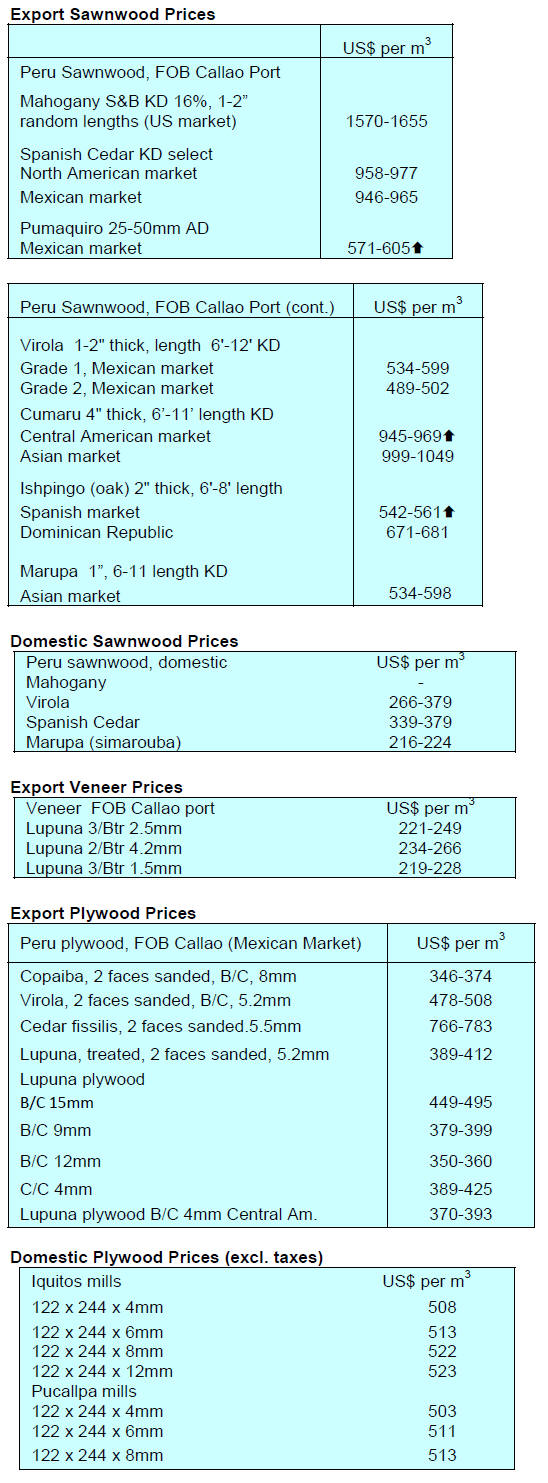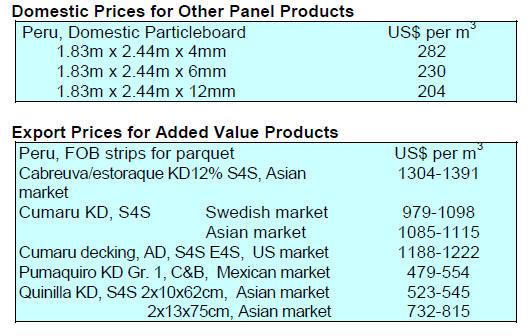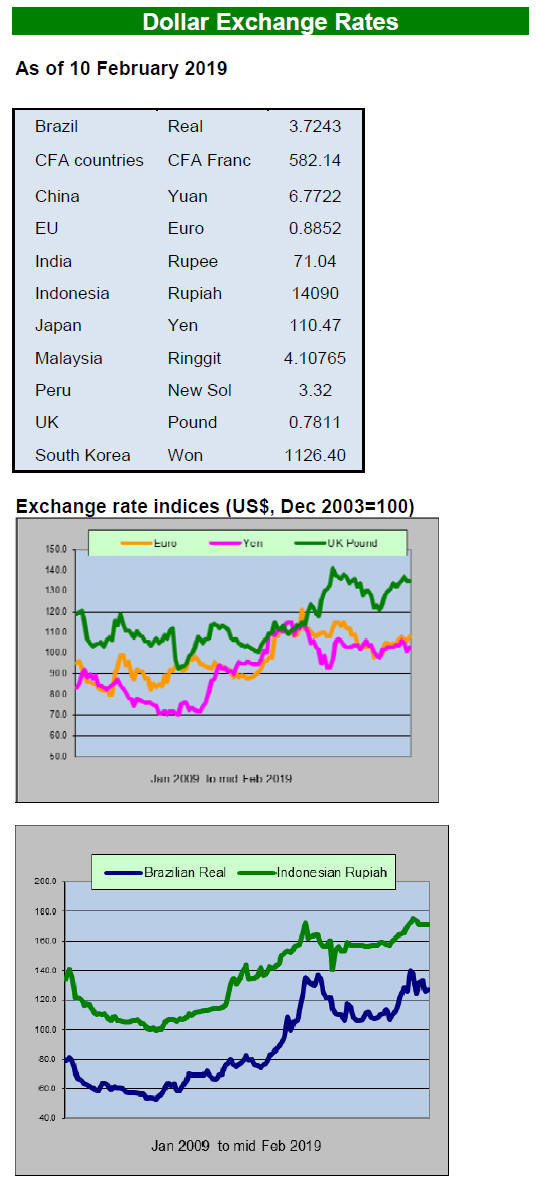3.
MALAYSIA
Bumiputera timber companies assisted
to secure
contracts with major corporations
As is the case in most Asian countries which celebrate
Chinese New Year, business activity slowed in early
February in Malaysia. It may take a week or two for some
industries to rev-up production.
The Ministry of Primary Industries has established a
dedicated mechanism termed the Special Purpose Vehicle
(SPV) within the Certified Timber and Credit Suppliers
(CTCS) programme operated by the Malaysian Timber
Industry Board (MTIB).
The aim of the SPV is to assist Bumiputera companies
secure contracts to supply wood products to corporations
in the construction sector. In Malaysia the term
Bumiputera refers to Malays, Orang Asli and natives of
Sabah and Sarawak.
The CTCS programme was featured in the ITTO Market
Discussion in November 2015 when the International
Tropical Council met in Kuala Lumpur.
Teresa Kok, Minister of Primary Industries, has said the
government has identified key performance indicators for
the purpose of monitoring the programme which aims to
boost the contribution to the economy of Bumiputera
entrepreneurs.
Sarawak pushes forward plantation target
The Sarawak State government has issued 43 industrial
plantation forest licenses to meet its target of one million
hectares of plantations by 2020 however, due to the slow
progress in planting by the private sector, the deadline to
achieve the plantation target has been pushed forward to
2025.
As of the end of January just over 420,000 hectares have
been planted according to the Sarawak Chief Minister.
Harvesting of industrial forest plantation in Sarawak began
in 2011 with log production of 44,000 cubic metres but in
2018 log production from the planted forests was about
1.72 million cubic metres.
Sabah researches cross laminated timber
Joint research by a student team from the University
Malaysia, Sabah (UMS), Wood Technology and Industry
Unit and the Sapulut Forest Development Company has
shown plantation timbers such as ‘laran’ and ‘batai’ are
potential species for use in the production of Cross
Laminated Timber (CLT) products.
CLT is not a new product concept internationally but has
not found application in Asia. The first high rise CLT
building is said to be under consideration by the Nanyang
Technological University in Singapore.
Dr Liew Kang Chiang, Associate Professor in the Faculty
of Science and Natural Resources at UMS, said the team
focused on timber strength and durability and that the
results were promising. Looking to the future, Dr, Liew
said the challenge will be to adapt building regulations to
accommodate this new product.
Plywood traders based in Sarawak reported the following
export prices for mid-January 2019:
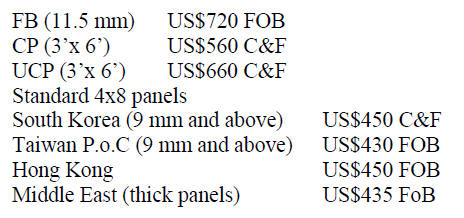
4.
INDONESIA
Urgent need to boost exports
– regulations to be eased
Darmin Nasution, Indonesian Coordinating Minister for
Economic Affairs, said the government will simplify and
ease regulations governing exports in order to boost the
current account so as to address the 2018 US$8.57 billion
trade deficit.
While this is only a short-term measure Darmin indicated
the government was also developing medium-term and
long-term strategies to enhance exports.
Exporters welcomed this move by the government saying
the number of the commodities requiring surveyor reports
(LS's) delays exports and adds to costs. In praising the
government’s initiative, Exporters Association
(GPEI) chairman, Benny Soetrisno, expressed concern that
this short-term measure will help but is seeking a longer
term solution.
In related news, the deputy chairman of the Indonesian
Employers Association (Apindo) called for a continuous
review of regulations and the introduction of better
incentives to encourage exports, pointing out that while
incentives in the form of tax breaks exist the process to
secure the incentive is so cumbersome and time
consuming that many companies do not take advantage of
this.
Beginning February 2019 it is planned that four export
commodities will exempted from surveyor’s reports
namely crude palm oil and its derivatives, gas, semifinished
rattan and logs from industrial plantations. It is
unclear yet when wood products will be exempted.
Success in peatland restoration
The Ministry of Environment and Forestry has reported
that in 2018 some 3.1 million hectares of degraded
peatland was been partly restored through securing an
adequate level of moisture in the peat.
A spokesperson from the Ministry said initially it was
difficult to get companies to cooperate with the restoration
effort but now companies are aware of the significance of
the peat eco-system. The Ministry of Environment and
Forestry has a database for monitoring groundwater levels
and rainfall in restored areas.
Increased employment in manufacturing will benefit
economy
Indonesia’s manufacturing sector can be the new engine of
growth according to the National Development Planning
Agency (Bappenas). A joint report by the Asian
Development Bank (ADB) and Bappenas estimates that
Indonesia could achieve a growth rate of 6.3% between
2020 and 2024 in a scenario where employment in the
manufacturing sector increases. The report says if jobs are
not created in manufacturing then GDP will be around 1%
lower.
Developing the manufacturing sector is vital to efforts to
shift the country away from its lift dependence on raw
materials. To achieve this new direction the government
will now stress the value-added manufacturing sector to
diversify exports.
More than 30% of Indonesia’s exports in 2018 were of
commodities such as coal, vegetable oil and fats, natural
gas and petroleum products.
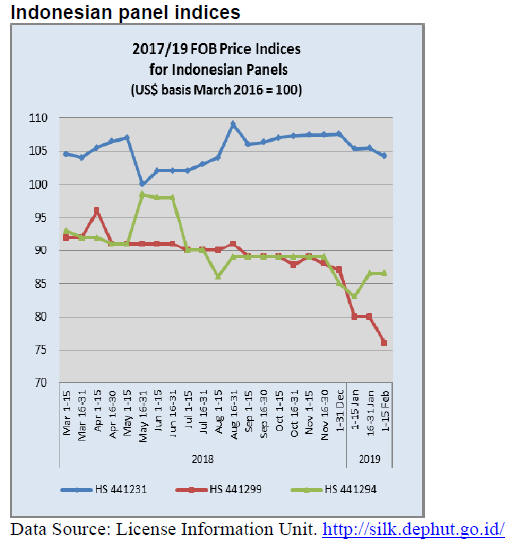
5.
MYANMAR
MTE to help meet demand of cottage
industries in
Mandalay
The Myanma Timber Enterprise (MTE) office in the
Mandalay Region has announced it will sell 5,400 tons of
logs and sawnwood to local mills and cottage industries.
The purpose of the sale is to ensure local processors have
access to legally harvested raw materials and thus do not
have to revert to illegal logging. One of the drivers of
illegal logging, say analysts, is the inadequate supply of
timber to local industries.
The Forest Department has indicated it plans to demolish
much of the road network used by illegal loggers in the
Bago Mountain range. Analysts report that illegal logging
is still rampant in remote areas despite the 10-year logging
ban in the mountain range.
Industrial zone report announced
A press release from Businesswire has introduced its
research into more than 100 active, developing and
proposed industrial zone projects across Myanmar,
surveying details such as size, pricing, infrastructure,
occupancy and tenants.
Businesswire says research conducted over three months
through site visits and interviews provides a
comprehensive analysis of an aspect of the Myanmar
economy that holds significant future growth potential but
has remained relatively opaque. The review is being
promoted as resource for manufacturers, investors,
contractors, suppliers, lenders, developers and a range of
other organisations active in the manufacturing sector.
See:
https://www.businesswire.com/news/home/20190215005186/en/
Myanmar-Industrial-Zone-Review-Project-Profiles-2019
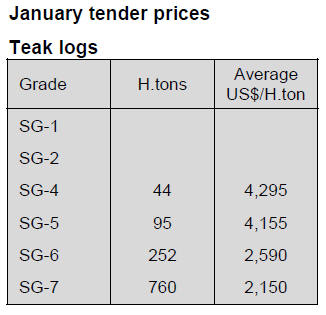

6. INDIA
Price indices confirm staedy demand
India’s official wholesale price index for all commodities
(Base: 2011-12=100) for December 2018 released by the
Office of the Economic Adviser to the government rose to
133.9 from 133.5 for the previous month due to higher
prices for sawnwood, wooden crates, panels and veneers
however, particleboard prices declined slightly in
December.
The annual rate of inflation based on monthly WPI in
December 2018 was 3.84% compared to 4.64% for the
previous month.
The press release from the Ministry of Commerce and
Industry can be found at:
http://eaindustry.nic.in/cmonthly.pdf

Gujarat eliminates license
requirement for timber
industries
In an effort to boost investment in processing the State
government in Gujarat has removed the license
requirement for factories utilising imported wood raw
materials.
The official notification from the State Forest Department
explains that sawmills, veneer mills, plywood plants, MDF
plants and other factories using imported wood will only
need to register with State authorities. Analysts write that
this move will especially benefit plywood factories using
imported veneers.
The change in license system also applies to companies
utilising domestic raw materials from plantations and
farms, a move aimed at encouraging agro-forestry.
Ikea tie-up with local real estate company
The construction company Rustomjee Group has secured
an arrangement with IKEA, the Swedish home furnishings
company, for the supply of ready-to-assemble furniture for
a building project near Mumbai. The Indian media are
quoting the management of the Rustomjee Group as
saying if this pilot arrangement is a success it could be
extended to cover other residential developments.
In October last year IKEA had a ground-breaking
ceremony for its third store in India in Nagasandra,
Bengaluru. This followed the opening of its first store in
Hyderabad two months earlier.
Plantation teak prices
In the current quiet housing market builders have been
trying to lower costs and this is beginning to affect the use
of teak, even plantation teak. Analysts write that recently
sales of apartments have risen but new builing projects
have been delayed until the market picks up.
With slow housing sales, demand for wooden furniture has
been depressed.
The Rupee/ US dollar exchange rate is holding steady at
around Rs.71 to the dollar and importers anticipate this
rate will be sustained for the time being.
C&F prices for plantation teak landed at Indian ports are
within the same range as shown in the previous report.


Locally sawn hardwood prices
Prices for imported hardwood sawnwood remain
unchanged from a month earlier.

Myanmar teak prices
The market in India for high quality Myanmar teak joinery
and furniture products is limited to high net worth clients
such that demand is little affected by trends in the
economy. Never-the-less this niche market is small. Much
of the teak from Myanmar is processed in India for export
and exports remain firm.

Sawn hardwood prices
Prices for sawn hardwood imports remain unchanged.

Plywood
Plywood mills in India that are dependent on imports of
face veneer from Gabon are facing problems in that
shipments are delayed because of the port congestion.
Analysts report that some have been lucky to secure
alternative sources in SE Asia.

At the end of last year there were already signs of
oversupply of composite panels and this continues. Prices
for both MDF and particleboards are under downward
pressure in the local market.
Weakening prices and rising production costs are
becoming a serious issue for manufacturers.
Several states have encouraged expansion of the panel
sector but this has put pressure on raw material supply. In
these circumstances it is even more imperative that the
industry seeks a reduction in GST from 12% to 8%.
7. BRAZIL
Refinements made to strengthen
‘Control of Origin’
system
The National System for the ‘Control of Origin of Forest
Products’ (Sinaflor) has been strengthened with the
addition of three new tools that will make it easier to
check production chain information across the country.
The new system can be accessed from mobile devices and
tablets.
In addition, beginning in December last, a Business
Intelligence (BI) portal that allows analysis of data
generated by Sinaflo was established allowing real time
decision making.
The BI platform already offers analysis of data related to
timber species, forest products and transportation in
addition to information on users and wood stocks
registered in the Document of Forest Origin (DOF)
system.
Another tool to support Sinaflor is a mobile application
that facilitates field data log-in and reporting of wood
harvesting. Sinaflor is currently developing a Distance
Learning Platform (Ensino a Distância - EAD) that will
enable new operators and public servants to be trained
remotely.
Upward trend in furniture prices
Price volatility in the furniture industry was slightly lower
in December from the previous month according to
Brazilian Institute of Geography and Statistics (IBGE).
Over the same period 13 out of the 24 sub-sectors
examined reported positive price changes compared to 10
out of 24 in the previous month. IBGE has reported that
prices of furniture rose almost 10% in 2018. Over the past
9 years the average price adjustment in the furniture
industry was +8% per year.
Feasibility of shipping from Imbituba Port to the EU
A delegation of importers and traders from Sweden
recently visited Santa Catarina in Southern Brazil and paid
a visit to the Imbituba Port complex. The purpose of the
visit was to assess the feasibility of importing wood
products through the Imbituba Port. If it turns out to be a
viable option shipments of wood products to Europe from
the port could be arranged every 45 days.
The Administrative, Commercial and Financial Director of
the Santa Catarina (SCPAR) Imbituba Port pointed out
during the meeting with the Swedish delegation that
timber shipments from Imbituba Port began last year when
the first ship loaded with pine and eucalyptus logs was
shipped to China. The Director also mentioned that the
port can handle many types of cargo and has top class
storage and handling equipment.
Forest product exports help eliminate trade deficit
According to the Ministry of Agriculture, exports of paper,
pulp and other wood products, totalled US$14.2 billion,
23% more than in 2017 and the export of forest products
reached a highpoint last year lifting the ranking of the
sector to second place in the ranking of agribusiness
exports. In past years forest product exports were fourth
ranked.
The volume and price of pulp help boost the performance
of the timber sector exports driven by firm international
demand in 2018. For example China increased its pulp
imports from Brazil.
In the final quarter of 2018 China purchased 1.7 million
tonnes of pulp from Brazil, 38% more than in the same
period of 2017. However, analysts anticipate a decline in
pulp prices in 2019.
Pulp price has been rising since January 2017 but
increased stock levels in China will eventually lead to
softening prices.2018 was good for pulp producers but not
so good for other sectors. The increase in exports by the
forestry sector helped the country eliminate its trade
deficits which had lingered since 2000.

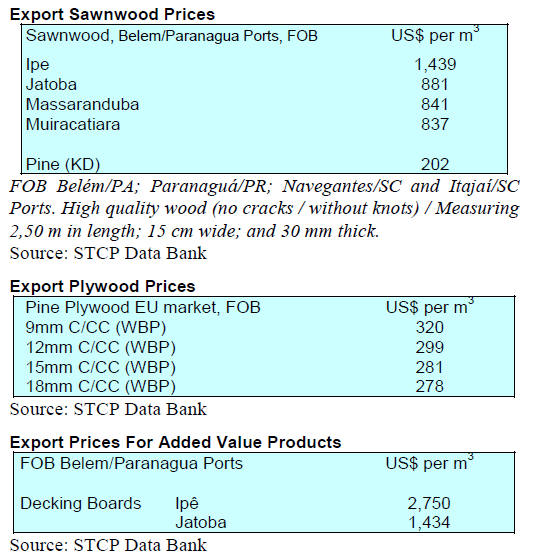
8. PERU
Imports of composite panels
exceeded US$100 million
in 2018
Peru’s imports of composite panels (particleboard and
MDF) totalled US$103.2 million in 2018 an increase of
19% year on year.
Shipments from Ecuador were valued at US$40 million up
22% year on year. Imports from Chile were worth US$31
million and this represented a rise of 12% year on year.
While imports of composite panels from Brazil were only
worth US$16 million there was a massive increase in 2018
shipments surging 46% compared to a year earlier. For the
first time shipments from Brazil surpassed those from
Spain (2018, US$15.5 million).
Support for regional investment in plantations and
restoration
The new Multi-annual Investment Programme 2019-2021
established by the National Forestry and Wildlife Service
(Serfor) provides an opportunity for central government,
regional and local government entities to submit proposals
for financing of investment projects in the areas of
commercial forest plantations, restoration of degraded
ecosystems and implementation of forest zoning.
A major aim of this initiative is to expand the accessible
resource base and create the supply of around 1.4 million
cubic metres of raw material for the production of
sawnwood, furniture, flooring and panels. Regional and
local governments have been invited to formulate
investment projects oriented to forest plantations.
The Serfor initiative also aims to achieve the restoration of
around 750,000 ha. of degrade forest especially in
watersheds and areas susceptible to landslides and floods,
fragile ecosystems and wetlands.
The intention is to bring a much larger area than
at present
under professional management.
